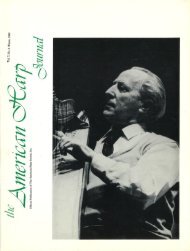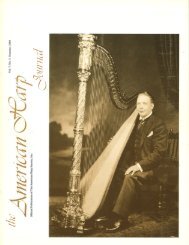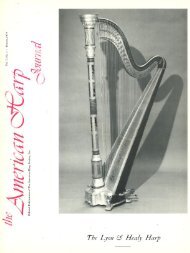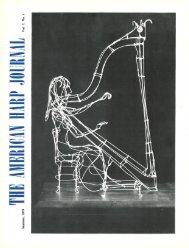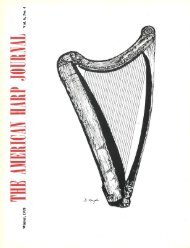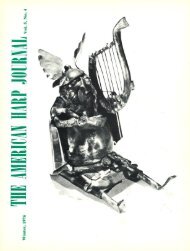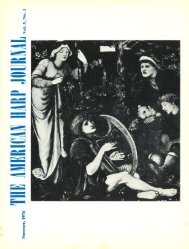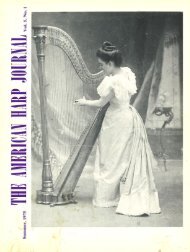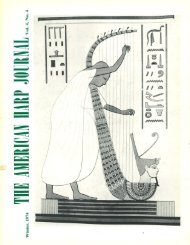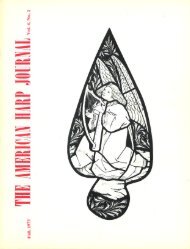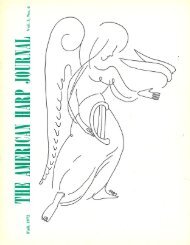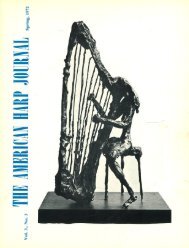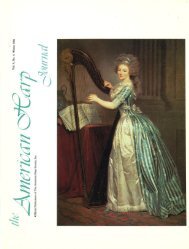Create successful ePaper yourself
Turn your PDF publications into a flip-book with our unique Google optimized e-Paper software.
Salvatore Mario de Stefano<br />
by Lucile High Jennings<br />
Salvatore Mario de Stefano lives just around the<br />
corner from Carnegie Hall, in one of those impressive<br />
stone structures, ornately carved over two facades,<br />
which proclaim their unwavering individuality in the<br />
constantly-changing architectural maze of New York<br />
City.<br />
Maestro de Stefano greeted me cordially at the door<br />
of his apartment and invited me into a parlor-studio<br />
furnished with two harps, a grand piano, and the furnishings<br />
and pictures and other memorabilia that speak<br />
of a long and fascinating life in the concert world.<br />
Born on the island of Sardinia, at Cagliari, Salvatore<br />
Mario de Stefano was a harp pupil of Caramiello at the<br />
Royal Conservatorio in Naples. His teacher, who had<br />
been a colleague of Hasselmans in Paris, led a double<br />
career, as he was also Consul to the small monarchy of<br />
Montenegro, whose young princess had become Victor<br />
Emmanuel's wife and therefore Queen of Italy. The<br />
young de Stefano served his teacher as secretary in this<br />
diplomatic function, and thus participated in the glittering<br />
life of an international circle. While still a young<br />
man, he emigrated to the United States and began a<br />
career as soloist and orchestral harpist.<br />
He showed me a clipping from a 1921 issue of the<br />
New York Times, which featured a concert of 60 harps<br />
playing in Carnegie Hall, with Mario de Stefano and<br />
Carlos Salzedo as soloists. As he reminisced about the<br />
high points of his career, I heard of tours all over the<br />
U.S., several seasons of playing as soloist with the Boston<br />
Pops, many experiences with the Bolshoi Ballet,<br />
Sadlers Wells Ballet, and Leningrad Ballet-when he<br />
was famous for his cadenzas in "Nutcracker Suite,"<br />
"Swan Lake," and "Sleeping Beauty," and for his orchestral<br />
sound in "Daphnis and Chloe"-to mention<br />
only a few. He is well-known to listeners to New York<br />
stations WOR and WQXR; at one point he played a regular<br />
weekly series of harp music on Sunday afternoons<br />
over a period of two years. "I played everythingclassical,<br />
romantic, modern-soup to nuts," he said<br />
SPRING/<strong>1974</strong><br />
this included concertos or chamber works by Zabel,<br />
Tournier, Oberthur, Mozart, Ravel, and Debussy.<br />
His musical career has not been limited to playing<br />
the harp, but has also included conducting and composition.<br />
As a composer, de Stefano has added to the repertoire<br />
the delightful "Variations on a Theme of<br />
Corelli," which he played for me, to indicate tempi and<br />
styles for the different variations. It is now published<br />
by Lyra House, as is his transcription of a posthumous<br />
"<strong>No</strong>cturne" of Chopin-a beautiful work with a singing<br />
melody. As he played that, I was much impressed<br />
with the singing legato line he achieved, and awed by<br />
his effortless one-hand trill.<br />
What method does he use? This is a question he<br />
would like to talk about. "Too many people are fanatics<br />
about 'method,' " he said. "There are many methods<br />
and all of them have good points. There are really three<br />
things to remember if you want to play the harp well:<br />
first, relaxation; second, sonority; and third, phrasing."<br />
He added that prehaps relaxation is the most important<br />
of all, since it affects the other two.<br />
Expressing himself on this subject, Mr. de Stefano<br />
mused about the origins of all contemporary harpists<br />
and harp methods. "Really, almost all of them go back<br />
to Hasselmans, if you trace their inheritance," he<br />
pointed out. "Hasselmans was the teacher of<br />
Salzedo, Ada Sassoli, Renie (who taught Grandjany),<br />
Tournier (who taught Zabaleta), and many others."<br />
Mr. de Stefano regrets very much the current contempt<br />
for Hasselmans' music, among harpists. He terms<br />
him the "poet of the harp" and advises harpists to play<br />
Hasselmans compositions in order to work on their tone<br />
and their phrasing.<br />
Asked about the happiest memories of his harp<br />
career, Mr. de Stefano named the three occasions when<br />
he was asked to play at the White House--once for<br />
Prec;ident Coolidge and twice for President Roosevelt.<br />
(Eleanor Roosevelt was entranced with a little "Music<br />
3




